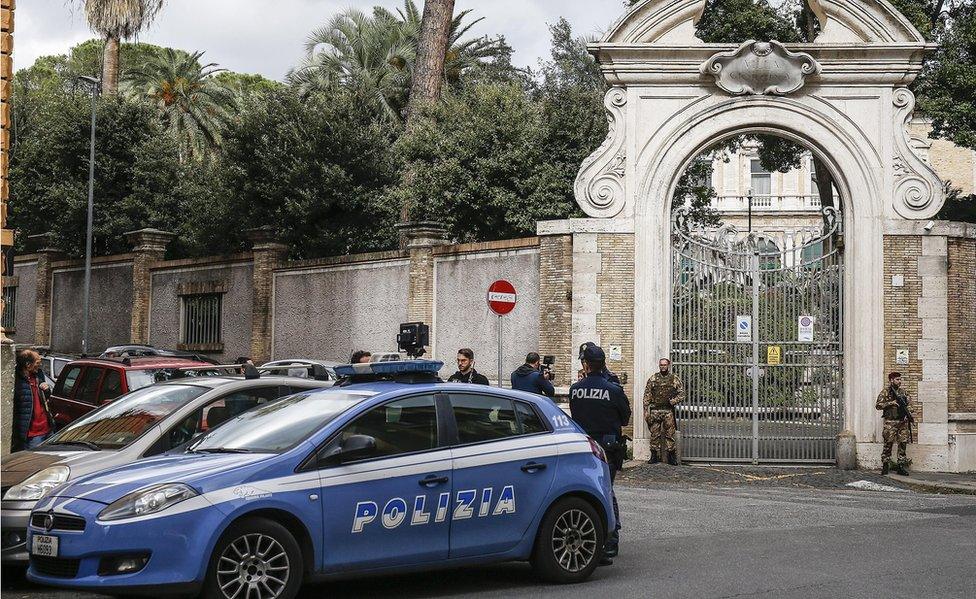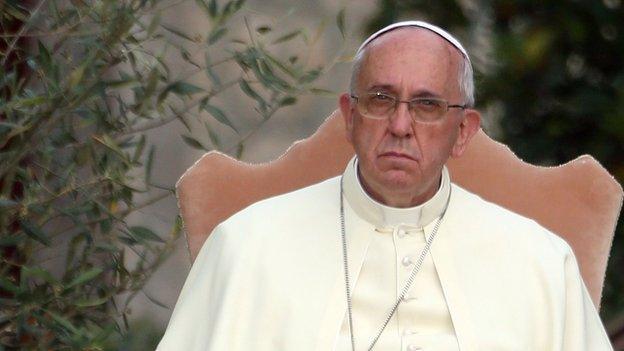Vatican Orlandi mystery: 'Woman's bones' found in Rome search
- Published

Italian authorities have been investigating the remains found at the Apostolic Nunciature in Rome's Via Po
Initial examination of bones found at the Vatican's embassy in Rome suggest they belong to a woman, reports say, heightening speculation that the discovery could solve a 1980s mystery.
An almost complete skeleton as well as other bones were found by workers at the property on Monday.
The find has raised the hopes of the families of two 15-year-old girls who disappeared in Rome in 1983.
One of the girls, Emanuela Orlandi, was a Vatican citizen.
Four men renovating a basement floor near the Vatican's Apostolic Nunciature found the bones. "We were digging and had removed the floor, then we saw the bones and immediately raised the alarm," said one of the workers.
Vatican gendarmes quickly passed the information to the Holy See who told the Rome authorities.
The Italian authorities then launched an inquiry to find out if the remains belonged to missing girls Emanuela Orlandi and Mirella Gregori.
By examining a pelvic bone at the site, researchers concluded that the remains belonged to a woman, reports say. They will now try to extract DNA from the teeth and skulls in order to compare it with that of the girls.
Investigators are expected to complete DNA tests on the bones within 10 days.
What links the missing girls to this property?
There is no definite connection, although Emanuela Orlandi's father was a Vatican employee, so had a possible link to the nunciature in the Via Po in Rome.
She has not been seen 22 June 1983, when she disappeared after a flute lesson in the centre of Rome. She was last seen at a bus stop.
Among those previously speculatively linked to her presumed kidnapping have been a murdered Italian mobster, Enrico de Pedis, as well as a gang trying to secure the release of a Turkish gunman who tried to assassinate Pope John Paul II in 1981.
Mirella Gregori, also 15, disappeared six weeks before Orlandi, in May 1983. The two families have always believed the cases are connected.

Emanuela Orlandi's brother said he did not want to get his hopes up that his sister's remains may have been found
Human remains have often been found before below the floors of Vatican buildings, and Vatican sources suggested there had once been a cemetery at the nunciature.
However, Italian media report that the floor involved was last renovated in the 1980s, and that the manner of burial suggested those involved had not died of natural causes.
How have the families reacted?
Emanuela Orlandi's brother was cautious when he appeared on Italian TV on Wednesday night, warning that the family had had too many disappointments in the past.
"I was amazed the Vatican police immediately came up with the idea that it could be the remains of Emanuela and Mirella Gregori. How did they make the connection?" he wondered.

A mural in Rome commemorates missing girls Emanuela Orlandi (R) and Mirella Gregori
Antonietta Gregori told Italian media she hoped the remains were her sister's.
"I don't want to fool myself," she said. "I want to keep my feet on the ground but in my heart I hope that the bones are Mirella's so we can bring this story to an end and I will have somewhere to cry and to lay a flower for my sister."
- Published14 May 2012

- Published12 June 2014
